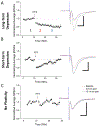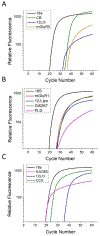Expression of type I mGluRs predicts plasticity in the hippocampal stratum radiatum interneurons
- PMID: 31499135
- PMCID: PMC6894514
- DOI: 10.1016/j.neulet.2019.134472
Expression of type I mGluRs predicts plasticity in the hippocampal stratum radiatum interneurons
Abstract
Changes in synaptic strength between hippocampal CA1 pyramidal cell synapses are partly responsible for memory acquisition. This plasticity is modulated by feedforward inhibitory interneurons in the stratum radiatum. While radiatum interneurons experience either long-term depression (LTD), short-term depression (STD), or lack plasticity, it is unclear whether plasticity correlates to specific interneuron subtypes. Using whole-cell electrophysiology and real-time quantitative PCR, we characterized the plasticity expressed by different interneuron subtypes. We first analyzed calcium binding proteins and cholecystokinin mRNA expression patterns to determine cell subtype. We then assessed endocannabinoid (eCB) biosynthetic enzyme mRNA expression, including diacylglycerol lipase α, N-acyl-phosphatidylethanolamine phospholipase D, and 12-lipoxygenase, and metabotropic glutamate receptors that often mediate plasticity. Neurons exhibiting LTD tended to co-express mRNA for at least one eCB biosynthetic enzyme and the metabotropic glutamate receptor 5 (mGluR5). Conversely, mGluR5 was not expressed by neurons exhibiting STD or no plasticity. Neurons that exhibited STD tended to express mRNA for at least one eCB biosynthetic enzyme and mGluR1, but not mGluR5. This suggests that plasticity of stratum radiatum interneurons could be predicted based on type I mGluR expression.
Keywords: 12-LO; DAGLα; Hippocampus; LTD; NAPE-PLD; Synaptic plasticity; mGluR1; mGluR5.
Copyright © 2019 Elsevier B.V. All rights reserved.
Conflict of interest statement
Conflict of Interest: There is no conflict of interest for any of the authors.
Figures


Similar articles
-
Cell-type specific GABA synaptic transmission and activity-dependent plasticity in rat hippocampal stratum radiatum interneurons.Eur J Neurosci. 2005 Jul;22(1):179-88. doi: 10.1111/j.1460-9568.2005.04207.x. Eur J Neurosci. 2005. PMID: 16029207
-
A novel non-CB1/TRPV1 endocannabinoid-mediated mechanism depresses excitatory synapses on hippocampal CA1 interneurons.Hippocampus. 2012 Feb;22(2):209-21. doi: 10.1002/hipo.20884. Epub 2010 Nov 10. Hippocampus. 2012. PMID: 21069781 Free PMC article.
-
Selective induction of metabotropic glutamate receptor 1- and metabotropic glutamate receptor 5-dependent chemical long-term potentiation at oriens/alveus interneuron synapses of mouse hippocampus.Neuroscience. 2008 Jan 2;151(1):28-42. doi: 10.1016/j.neuroscience.2007.09.071. Epub 2007 Oct 11. Neuroscience. 2008. PMID: 18035501
-
Roles for Arc in metabotropic glutamate receptor-dependent LTD and synapse elimination: Implications in health and disease.Semin Cell Dev Biol. 2018 May;77:51-62. doi: 10.1016/j.semcdb.2017.09.035. Epub 2017 Oct 14. Semin Cell Dev Biol. 2018. PMID: 28969983 Free PMC article. Review.
-
Updates on the Physiopathology of Group I Metabotropic Glutamate Receptors (mGluRI)-Dependent Long-Term Depression.Cells. 2023 Jun 8;12(12):1588. doi: 10.3390/cells12121588. Cells. 2023. PMID: 37371058 Free PMC article. Review.
Cited by
-
Plasma endocannabinoids in cocaine dependence and their relation to cerebral metabotropic glutamate receptor 5 density.Transl Psychiatry. 2023 Oct 19;13(1):325. doi: 10.1038/s41398-023-02628-7. Transl Psychiatry. 2023. PMID: 37857616 Free PMC article.
References
Publication types
MeSH terms
Substances
Grants and funding
LinkOut - more resources
Full Text Sources
Research Materials
Miscellaneous

